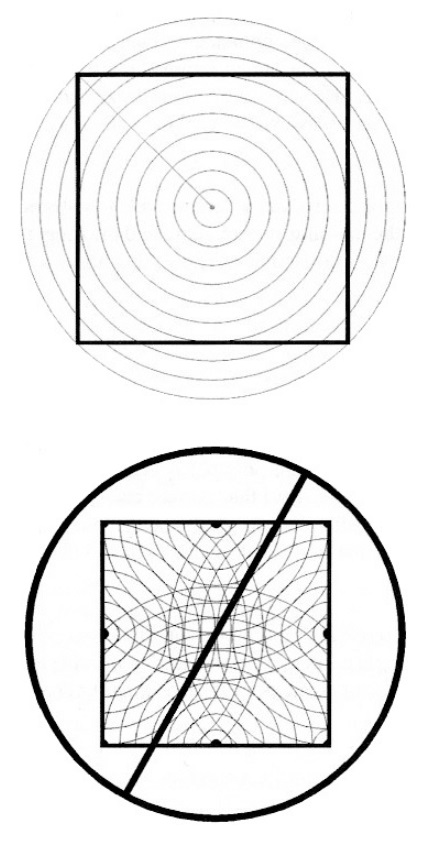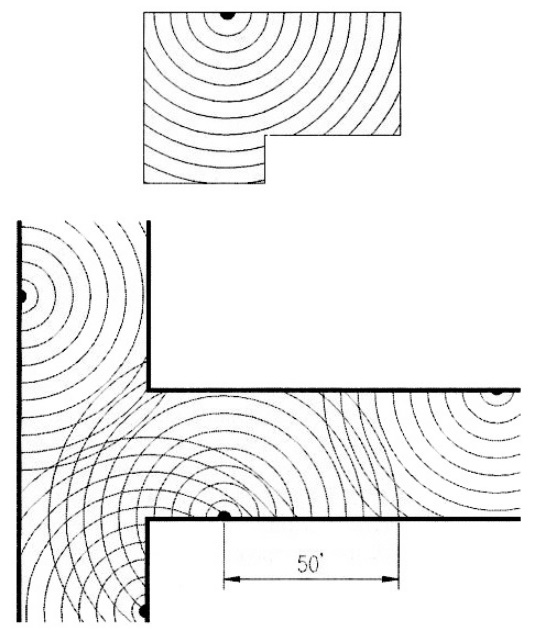Visual Alarms [4.28.3]
In general, it is not sufficient to install visual signals only at audible alarm locations. Audible alarms installed in corridors and lobbies can be heard in adjacent rooms but a visual signal can be observed only within the space it occupies. Visual alarms are required in hallways, lobbies, restrooms, and any other general usage and common use areas, such as meeting and conference rooms, classrooms, cafeterias, employee break rooms, dressing rooms, examination rooms and similar spaces. Visual alarms are not required in areas used solely as employee work areas or in mechanical, electrical, or telephone closets, janitor's closets, or similar non-occupiable spaces. The technical requirements apply to single-station and building-wide alarm systems and are based in part on research sponsored by the Access Board as well as Underwriters Laboratories (UL). The requirements do not preclude use of zoned or coded alarm systems.
Strobe Type and Color
Research indicates high-intensity xenon strobe lamps to be the most effective and white light the most discernible. Colored lamps, particularly red, were found to be ineffective even at very high intensities.
Intensity
To be effective, a visual signal (or its reflection from adjacent walls and ceiling) must be of an intensity that will raise the overall light level sharply, but not be so intense as to be unsafe for direct viewing when installed at a specified mounting height. Lamp intensity is given in effective candela (cd), measured in use at the source. In research testing, 90% of subjects were alerted by a 75 cd signal mounted 50 feet away on the wall directly behind them.
Pulse Duration and Flash Rate
Visual alarm strobes produce a repetitive burst of high-intensity light. The repetition of this pulse at a regular interval is the flash rate. Pulse duration is the interval of the flash between signal build-up and decay and is limited as specified so that the signal is not temporarily blinding. A flash rate cycle between one to three Hz (flashes per second) is required based on research results.
Recommendation: Flash synchronization is an important consideration. Multiple strobes within a space, if not synchronized, can produce a composite flash rate in excess of 3 Hz. For example, two strobes set at 3 Hz in a room could generate a combined flash rate of 6 Hz. Flash rates above 5 Hz may trigger seizures in people with certain forms of epilepsy. This is a particular concern in schools, since children frequently are more affected by photosensitivity than are adults. In spaces with multiple strobes, composite flash rates above 5 Hz should be avoided by synchronizing or decreasing the flash rate. It may also be possible to decrease the number of strobes or increase the spacing between them by increasing their intensity.
Mounting Height
ADAAG specifies a signal height 80 inches above the highest floor level within the space or 6 inches below the ceiling, whichever is lower. (This can be measured to the centerline or to the bottom edge of the appliance). The 80 inch height is based on research indicating it to be the most effective for a 75 cd lamp. It is also consistent with the minimum headroom clearance required for protruding objects. However, photometric calculations of lamp intensity for mounting heights of 80 and 96 inches show only nominal differences and can be practically considered to be equivalent. In multi-purpose facilities where bleacher seating, athletic equipment, backdrops, or other moveable elements may at times be deployed or in libraries, convention centers and other building types where devices would not be visible when installed at the specified height, optimal signal placement may require study and the development of alternative intensity and placement calculations as an "equivalent facilitation" which permits departures from ADAAG specifications if equal or greater access is provided. What is most important is that strobes, whether projecting from walls or suspended from ceilings, be at least 6 inches below the ceiling plane to minimize smoke obscuration.
Location and Spacing
Rooms with an area than can be circumscribed by a circle 50 feet in radius can be covered by a single centrally located strobe of 75 cd. For very small rooms, such as examination, toilet, and dressing rooms, a single strobe of lesser intensity may well be sufficient as an equivalent facilitation.

Recommendations: In general, it is recommended that lamp intensity and spacing be maximized to allow the minimum number of fixtures within a room or space. Large high-ceilinged spaces may be best served by suspended flash tubes of very high intensity. (Lamps up to 1000 cd are available for such applications). Specifiers may be motivated to standardize on a minimum-candela fixture because they are less expensive to purchase and connect, more available, and simplify inventorying. This can lead to close spacing of low-intensity lamps, which is discouraged because of the effect of composite flashes on people with photosensitivity. It may be possible to serve some large rooms or corridor sections with a single appliance located on a perimeter wall or suspended below the ceiling so that the signal can spread throughout the space without obstruction by furnishings, equipment, or room geometry.
Provisions for the spacing of visual alarms in hallways and corridors generally require one fixture every 100 feet. Recommendations: In long corridors, such as in shopping malls and airport terminals, appliances should be spaced to minimize their number and the effect of a composite flash rate. Alternate placement between opposing corridor walls is recommended in minimizing the number of signals in a field of view. Particular care should be taken in locating lamps along window or storefront glazing that may intensify the flash rate due to reflection.


User Comments/Questions
Add Comment/Question